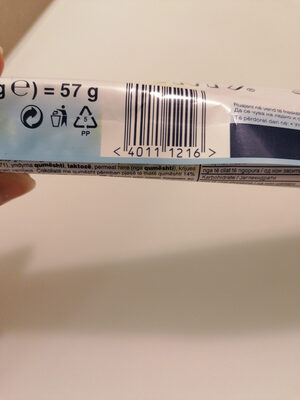Bounty (2-pakk) - Mars - 2 x 28,5 g
This product page is not complete. You can help to complete it by editing it and adding more data from the photos we have, or by taking more photos using the app for Android or iPhone/iPad. Thank you!
×
Barcode: 40111216
Common name: Moist tender coconut covered in thick milk chocolate
Quantity: 2 x 28,5 g
Packaging:
Plastic, Bag, Green dot, Mixed plastic film-wrapper
Brands: Mars
Categories: Snacks, Sweet snacks, Cocoa and its products, Confectioneries, Bars, Chocolate candies, Bars-covered-with-chocolate
Labels, certifications, awards:
Vegetarian, Green Dot, Pure cocoa butter
Origin of ingredients: fa:شرقی
Stores: Distributeur, Distributeur d'entreprise, Irma.dk, Tabac Presse Rennes Alma, Globus, Amazon
Countries where sold: Belgium, Czech Republic, Denmark, France, Germany, Hungary, Iran, Montenegro, Morocco, Réunion, Romania, Saudi Arabia, Serbia, Slovakia, Sweden, Switzerland, Tunisia, United Kingdom
Matching with your preferences
Report a problem
Data sources
Product added on by manu1400
Last edit of product page on by moon-rabbit.
Product page also edited by 9813601360, aleene, alia, anticultist, beniben, brandprivat, charlesnepote, date-limite-app, duhowpi, ecoscore-impact-estimator, feat, foodless, foodrepo, gyrostat, halal-app-chakib, inf, itsjustruby, kiliweb, mathias, off.88e72f90-38be-48e7-b17a-93bbe9b03892, olofolleola4, ompopo, openfood-ch-import, openfoodfacts-contributors, packbot, pampoum, phoenix, quechoisir, rapiteanu, rev01yeti, risajanda, scanbot, sebleouf, simongbe, swipe-studio, syphax007, tacite, tacite-mass-editor, tailot, yuka.SHZvR0tLYzZpTXNGaDgwVjAwelV3WW9sMmNPNWMxbnRNTHNqSVE9PQ, yuka.U1BFdEY2NFlyYWNPaWN3WHJpak4wL0F0NnJtNWYxdUtHODRzSVE9PQ, yuka.UktNdlBJQUxpdkEzdnMwem9DamVvOUpPbUsyMlFYaTZkL0VBSVE9PQ, yuka.UnBBRlNQZ01xZFVoc2RvKzIwK0xvdjlVbUwzeWNrNlRjdk13SUE9PQ, yuka.WWZBQ01mc3d0OVVHbGNOaHdFTEw5NE5QeG9hM1d6Mm1LT01CSWc9PQ, yuka.Wks4bUlwUWVvYVFtdy9CdjRFem4ydWhWd3BtcEJtNmRKL0pOSVE9PQ, yuka.Wm9VTURJMHZ0dllKd2NkdXBUbnc5ZlpmMWEydVVqL29CY0VlSVE9PQ, yuka.ZVlSWk5Kb09xK2NqdU5vc3pqWFAvY3NwK0orWVpFVzNCZVE3SVE9PQ, yuka.sY2b0xO6T85zoF3NwEKvlkBBXOLzmhv-Jgfgu2-77-6WE8CzMcBRzqP0Gas, yukafix, zixianglim, zoneblockscommunity.












